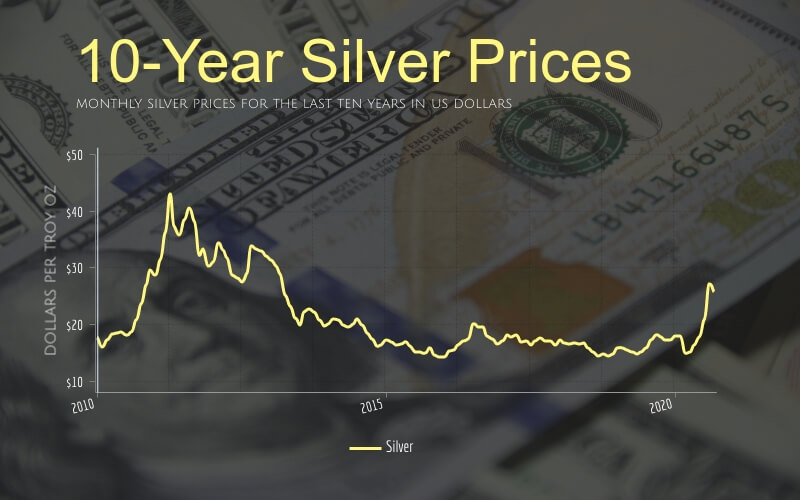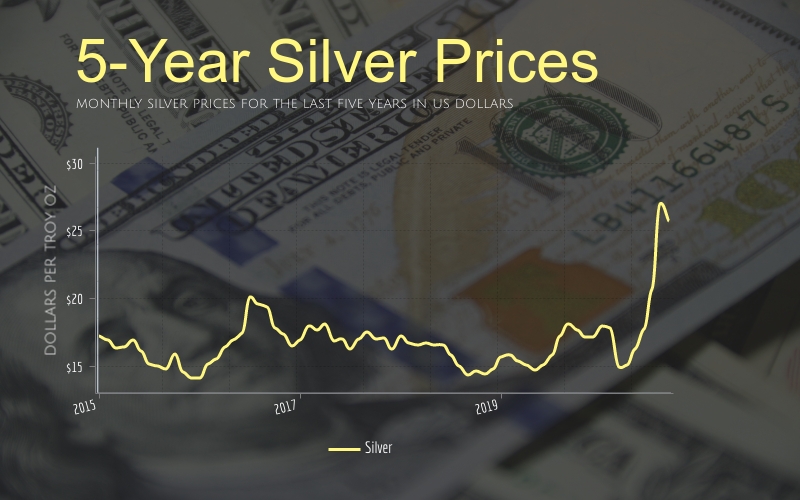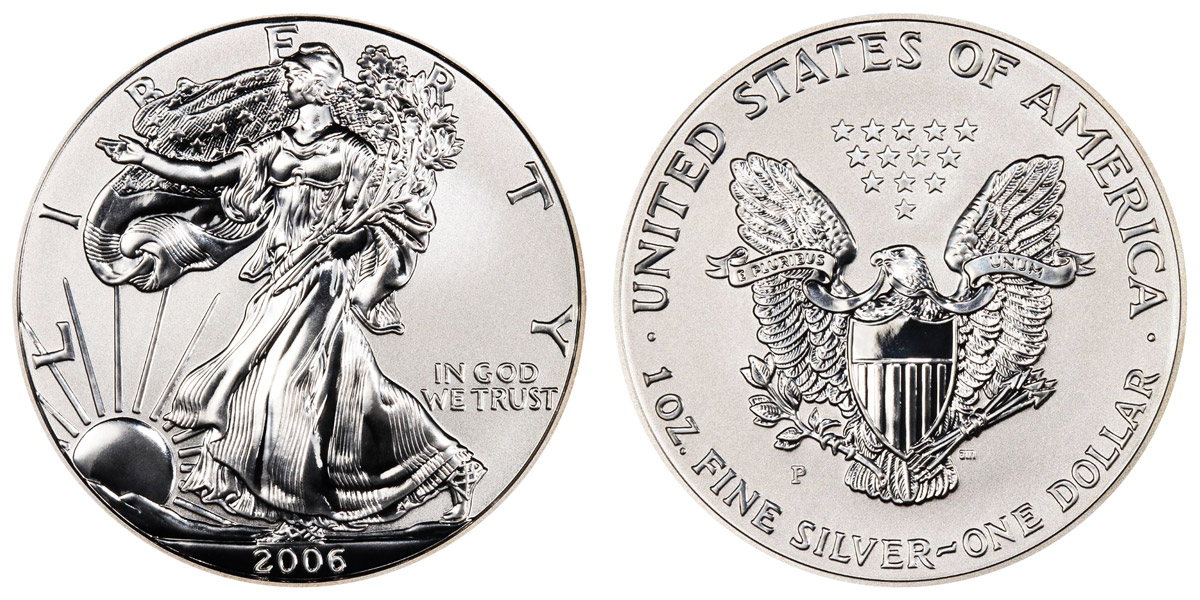Silver Price Prediction: 2022, 2023 and Beyond
The silver market has experienced considerable volatility over the past several years. Many predictions by market analysts have missed the mark as a result.
On balance, I have been bullish on silver since the beginning of 2016. Over that time, silver did climb back to the $20/oz range but struggled to surpass that level. Needless to say, I was early with my optimism.
Through my extensive experience in the bullion industry, I've witnessed both bear markets and bull markets in silver. I've also seen the sideways price action that usually characterizes the intervening periods.
I will explain my silver price forecast for the next two years (2022 and 2023) as well as looking farther out to 2030. I will provide my reasoning for these predictions and share some insights into my forecasting methods.
Silver Price Forecast for 2022: $21 per troy ounce
Silver Price Forecast for 2023: $25 per troy ounce
Silver Price Forecast for 2030: $35 per troy ounce
For Clues About Future Price of Silver, Look to the Recent Past
In the nearly 15 years since the global financial crisis in 2008, silver prices have experienced a bit of a roller coaster ride. After peaking in 2011 just shy of $50 per troy ounce, silver prices were mired in a bear market for the next nine years. Prices bottomed out around $14 per ounce at the beginning of the covid-19 pandemic in March 2020.

10-year silver price chart
I can sympathize with the pain of investors who have been holding silver throughout that decade-long slump. (Or, even worse, those that had to sell their silver at a loss.) Volatile markets can be difficult to stomach. Emotional responses such as "FOMO"—fear of missing out—may become overwhelming when other investments (e.g. stocks) are outperforming.
Nonetheless, with a tangible asset like silver, lower prices are always an opportunity to accumulate more physical ounces. This is especially true when the long-term bullish thesis for silver (discussed below) has not actually been invalidated.
Silver Price Prediction for 2022
If we look at silver's performance over the past five years, it would appear that a new bull market for silver began about mid-way through 2020.

5-year silver price chart
At the time of writing, the silver market has given back a portion of those strong gains. Prices are back near the $22/oz level, and investor sentiment has fallen in response to the price decline.
I'm not convinced that silver is quite ready to break out of its slump yet this year, especially amid the up-and-down movement of the stock market in 2022. Volatile markets mean some investors will sell silver to cover losses elsewhere in their investment portfolios. This predictable reaction drives prices lower. Moreover, if the global economy falls into a recession this year, industrial demand for silver could also suffer.
My silver price target for year-end in 2022 is $21 per troy ounce. That's slightly below the current price (about 1 percent lower), and well off of silver's previous high for the year.
Silver Price Prediction for 2023
In my estimation, the challenges facing the world economy aren't going to be resolved quickly. Certainly not by 2023.
Initially, that likely means more bad news for silver. We could get as low as the $17/oz handle at some point. But that type of downturn for silver will most likely be—to steal a buzzword from the Federal Reserve regarding inflation—"transitory."
I do expect more periodic struggles for silver over the next 18 months. Even as a silver bull, I must caution you that nothing you can own has a price that goes up in a straight line all the time. Not silver, not real estate, not Bitcoin, not even the S&P 500.
However, as an asset silver has an asymmetric upside relative to its downside. In other words, silver prices could fall by a modest amount in the future, but they could rise by a tremendous amount.
Other bullish predictions for silver have called for new all-time highs of $50 per ounce, or even triple-digit prices over $100/oz. The market will reach these milestones eventually, but such forecasts are overly optimistic in my view. Keep in mind that we still haven't meaningfully broken the $30/oz barrier during this current cycle that began in 2020.
With that in mind, my silver price target for year-end in 2023 is $25 per troy ounce. This would represent a roughly 13.5% gain over the current spot price. Compared to last year, 2021's average price for silver was right around $25/oz. It is also in line with data from the Silver Institute, which predicts silver will remain in a global supply deficit in the coming years.
Silver Price Prediction for 2030
I still have good reasons to believe that silver is an undervalued asset relative to other investments. The same is largely true for gold prices, but silver is subject to considerably higher volatility than gold.
Two things to keep in mind about the precious metal markets:
- 1) The gold and silver markets are usually cyclical, meaning they tend to follow cycles that cover multiple years;
- 2) Precious metals prices constantly fluctuate and never move in a straight line in one direction or the other.
Given these parameters, in my view silver is on the cusp of entering another bull market phase of this current market cycle. This simply means silver prices are expected to be higher in the coming years. My price target for silver by 2030 is $35 per troy ounce. On an historical basis, and in comparison to other major investment assets, silver would still be relatively undervalued at this price level.
I don't rule out the potential for a more explosive rise in prices closer to the $50 per ounce range. Remember, this would represent record high silver prices.
But we must also consider that the silver mining supply would likely rise in response to prices sustaining above $30/oz. Higher silver mine production would have some countervailing effect on a bullish silver market. The same is true if energy prices, like natural gas and crude oil, continue to rise. This is especially probable in light of silver's critical uses across many industries.
It's worth pointing out that strong demand for silver coins from the United States Mint means that 1 oz silver coins already tend to cost over $30 per coin for retail investors. This type of economic activity is a decent proxy for gauging investment demand for silver.
How My Silver Price Prediction Is Calculated
It's worth acknowledging that all forecasts are going to be imperfect, as are the tools and indicators that inform them. Of course, past performance is no guarantee of future results.
I tend to make conservative forecasts—particularly compared to other experts in the precious metals space. This inclination is informed by my firsthand experience in the silver market for the past decade. I have seen many gold price predictions fail to materialize time and again.
My thought process on making predictions is based on two major principles. First is the observation that financial markets tend to be cyclical. Although the time span of each cycle can vary, this concept is useful for evaluating the general direction of various asset prices.
I ask myself, are we in the bull portion of the cycle or the bear portion? Are we closer to the beginning, middle, or end of that cycle? The answer for silver is that we are just now entering the next bullish phase.
Second, no financial asset exists in a vacuum. It's always edifying to compare the relative values of other key "outside markets." This allows us to get a better sense of whether silver is "overbought" or "oversold" in the trading markets. For silver, the main indicators I look at are:
Gold-Silver Ratio (GSR)
This metric is simply the gold price divided by the silver price. It indicates how many ounces of silver it would take to buy one ounce of gold. Historically, when the gold-silver ratio exceeds 80:1, the ratio tends to move back into silver's favor.
As you can see in the graph below, it wouldn't be terribly surprising to see the GSR correct sharply to the 40:1 range—as it did in 2010 as well as the early 1980s. For reference, even if the gold price doesn't budge from its current level, this would put the silver price above $45/oz.
.png)
Chart of gold-silver ratio over the past 50 years. Shaded areas represent recessions. Macrotrends.net
Silver Price Moving Averages
Along the same lines, checking moving averages is another useful tool. Although moving averages are a lagging indicator, they are a good way to gauge broader trends. They are also key levels to watch if you conduct any technical analysis.
At the time of writing, these are silver's medium-term moving averages:
- 50-day moving average (50-DMA): $23.13
- 100-day moving average (100-DMA): $23.75
- 200-day moving average (200-DMA): $23.53
Because we see that the 50-DMA is lower than the 100-DMA, it's safe to say that silver has been in a downtrend this summer.
U.S. Money Supply (M2)
As a general rule, when the supply of money in a country increases, commodity prices and the price of tangible assets (like precious metals) tend to rise. The logic here makes it clear why silver can act as an inflation hedge. When silver demand stays the same, yet there is more money in the economy chasing the same number of resources, the nominal price of those resources goes up.
You can also see in the chart below that silver in particular tends to rally right before the U.S. money supply surges. This dynamic is undoubtedly the result of silver's long history of having monetary characteristics (i.e. silver's use as money and currency).
.png)
Silver price charted against changes in U.S. money supply (vertical green lines). Courtesy of @TheHappyHawaiian on Twitter
U.S. Dollar Index (DXY)
The DXY index is a rudimentary measure of the U.S. dollar's relative value against a basket of its major peer currencies. This mainly includes the euro and the Japanese yen.
You may be tempted to think that as the dollar gets stronger, the price of silver falls. Indeed, during periods of rapid economic expansion, there is normally a negative correlation between the silver price and the USD.
However, the opposite is often true amid an economic downturn or recession. Both the U.S. dollar and silver are considered traditional safe-haven assets. This means investors like to hold safe havens to protect their wealth when the economy falters. Thus, when the world faces challenging economic conditions, the dollar and silver can move upward in tandem.
U.S. Stock Market Indices
A stock index is a handy indicator for an entire sector of the stock market (rather than the price of a single stock). The three major stock indices in the United States are:
- the Dow Jones Industrial Average, often just called the Dow. It is the "blue chip" index of "mega cap" stocks, tracking the 30 largest companies listed on the New York Stock Exchange (NYSE)
- the Standard & Poor's 500, better known as the S&P 500. This is the broadest index of large cap stocks and is sometimes used as a stand-in for the entire stock market
- the Nasdaq 100, which primarily includes companies that operate in the technology sector.
Simply put, when equity prices struggle for a prolonged amount of time, investors will turn to safer assets such as silver and gold. Keep in mind that this is hardly a perfect 1:1 relationship. Still, the idea that silver prices generally go up when the stock market goes down is essentially correct.
What's Driving the Silver Price
The three key factors discussed below will have the greatest impact on the price of silver over the next 7–10 years.
1) hedging against inflation and a recession;
2) the growth of solar energy and electric vehicles;
3) higher gold prices.

American Silver Eagle, one of the most popular silver coins in the world.
1. Silver as a Hedge in Your Portfolio
This is where our earlier observation about the stock market comes into play. Equities have already experienced significant losses in 2022, and they may fall much farther. If the world economy does plunge into a recession, it's likely that stocks will trade lower or sideways for the following two- to three-year stretch.
In this scenario, silver prices may also stagnate, at least initially. (Just look at my silver forecast for 2022!) Yet the key point here is silver will retain more of its value in comparison to stocks and other risk assets. This will help insulate your portfolio from the worst carnage, maintaining and preserving your wealth during difficult economic times.
2. Silver's Use in Solar and EVs
Beyond seeing investment demand, silver is also an industrial metal. Silver is already an essential component in virtually all electronic applications and devices. Your mobile phone or computer screen that you're using to read this article would not exist without silver!
In addition to established industrial uses for silver in electronics and the medical field, silver will also play an important role in the industries of the future. Two high-growth fields that require silver as an input are solar energy and electric vehicles.
The photovoltaic cells of solar panels rely on a considerable supply of silver. This is because silver is the most efficient metal at conducting electricity known to humankind. Both India and China have already made large commitments to purchase billions of dollars' worth of solar panels. Solar capacity worldwide is also projected to grow dramatically by the year 2035.
Industrial demand for silver is already present with combustion engine vehicles. Yet electric vehicles require even more silver than traditional cars. So one of the driving forces for higher silver prices over the next five years is the white metal's many applications in green technologies and the "green economy."
You can read more about silver's amazing properties as a metal by following the link.
3. Silver Tends to Track the Gold Price
It may come as no surprise that the prices of gold and silver frequently move in the same direction. When gold drops, silver usually isn't far behind. When gold rallies, silver almost always rallies, too.
Given this relationship, the current macroeconomic landscape is increasingly favorable to gold. The gold price is quite likely to hit new all-time highs above $2,000 per ounce in the next two years. It's a reasonable assumption that silver will follow a similar path to this gold price forecast.
.png)
Comparison of gold price (blue, left axis) and silver price (orange, right axis). Shaded areas represent recessions. Macrotrends.net
Secondarily, one headwind for the gold market is the expectation that the U.S. central bank, the Federal Reserve, will be aggressively raising interest rates into 2023. Gold normally exhibits an inverse correlation to the real rate of interest (i.e. interest rates minus the rate of inflation).
Though this expectation about rising rates may prove to be dubious, this development would have a more pronounced effect on gold than silver. That sets the stage for silver to overperform gold and close the gap in the GSR mentioned above. All of this justifies the forecast for silver prices to increase by 50% or more by the end of this decade.
The information provided herein is intended solely for educational purposes. Any forward-looking statements about the silver price forecast should not be used or construed as investment advice. Do your own due diligence. Please consult a professional financial advisor for more information about investing before any investment decision.
Read more about the gold and silver markets from the authors at Gainesville Coins:
Is Silver a Good Investment in 2022?
Why Is Gold So Valuable? (Updated for 2022)
Why You Can't Buy Gold or Silver At Spot Price
Gold/Silver Ratio (GSR): Definition and Trading Strategies
6 Gold Buying Mistakes to Avoid
Silver Price Today - Silver Spot Price Chart

Everett Millman
Everett has been the head content writer and market analyst at Gainesville Coins since 2013. He has a background in History and is deeply interested in how gold and silver have historically fit into the financial system.
In addition to blogging, Everett's work has been featured in Reuters, CNN Business, Bloomberg Radio, TD Ameritrade Network, CoinWeek, and has been referenced by the Washington Post.
